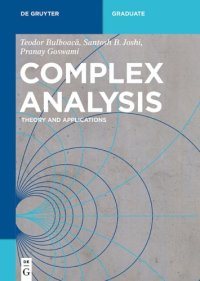
Ebook: Complex Analysis: Theory and Applications
- Genre: Mathematics
- Year: 2019
- Publisher: De Gruyter
- Language: English
- pdf
Complex analysis, as we know it now, is the culmination of over 500 years of mathe-
matical development that has had tremendous inᆴuence in mathematics, physics and
engineering. The numbers we now know as “complex” (a most unfortunate name due
to C. F. Gauss) made their Žrst appearance through the use of square roots of negative
numbers in methods for the solution of cubic and quartic equations1 in the works of
N. F. Tartaglia and G. Cardano and proved their value in “predicting” the correct val-
ues of roots. R. Descartes, who also coined the concept of a real number, named such
square roots of negative numbers imaginary, since they could “only” be imagined.
Leonhard Euler made extensive use of complex numbers and also introduced these2
in his textbooks. However, Euler also had only a vague geometric notion of complex
numbers and the complex plane. The geometrization of the complex numbers had to
wait until the end of the eighteenth century by the separate insights of J-R. Argand, C.
Wessel and Gauss. Much of the development of classical complex analysis, the topic of
this book, occurred in the nineteenth century in the hands of A-L. Cauchy and B. Rie-
mann followed by the even more geometrical work of F. Klein, H. Poincare and many
others.
matical development that has had tremendous inᆴuence in mathematics, physics and
engineering. The numbers we now know as “complex” (a most unfortunate name due
to C. F. Gauss) made their Žrst appearance through the use of square roots of negative
numbers in methods for the solution of cubic and quartic equations1 in the works of
N. F. Tartaglia and G. Cardano and proved their value in “predicting” the correct val-
ues of roots. R. Descartes, who also coined the concept of a real number, named such
square roots of negative numbers imaginary, since they could “only” be imagined.
Leonhard Euler made extensive use of complex numbers and also introduced these2
in his textbooks. However, Euler also had only a vague geometric notion of complex
numbers and the complex plane. The geometrization of the complex numbers had to
wait until the end of the eighteenth century by the separate insights of J-R. Argand, C.
Wessel and Gauss. Much of the development of classical complex analysis, the topic of
this book, occurred in the nineteenth century in the hands of A-L. Cauchy and B. Rie-
mann followed by the even more geometrical work of F. Klein, H. Poincare and many
others.
Download the book Complex Analysis: Theory and Applications for free or read online
Continue reading on any device:

Last viewed books
Related books
{related-news}
Comments (0)